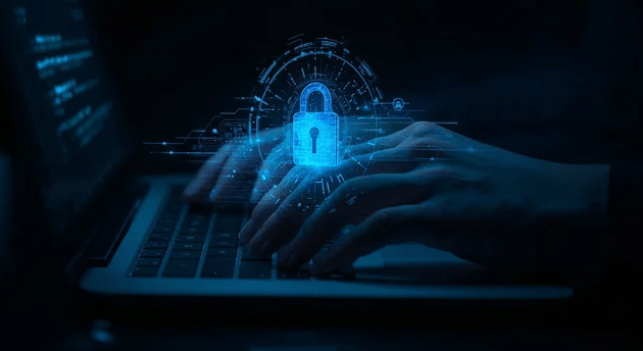Table of Contents
ToggleIntroduction.
In today’s digital age, the internet is woven into nearly every part of our lives from how we communicate and work, to how we shop, learn, and bank. As technology advances, so do the risks that come with it. With every click, tap, or swipe, we share a part of ourselves online often without even realizing it. From personal photos and social media posts to credit card numbers and health records, our digital footprint grows by the day. And where there is valuable data, there are always people looking to exploit it. That’s where cybersecurity comes in.
Cybersecurity is the practice of protecting computers, servers, mobile devices, networks, and data from digital attacks. These attacks often referred to as cyber threats can come from hackers, malicious software (malware), phishing emails, or even insider threats. The goal of cybersecurity is to ensure that your data remains confidential, your systems stay functional, and that no unauthorized person can access, alter, or destroy your information.
But cybersecurity isn’t just about firewalls and antivirus software. It’s also about awareness, behavior, and best practices. It’s about knowing how to spot a fake email, understanding why a strong password matters, and realizing that even something as simple as connecting to public Wi-Fi can pose a risk. In essence, cybersecurity is both a technological and a human issue.
Why should the average person care? Because cyber threats don’t just target large corporations or government systems. Everyday people are often the easiest targets. Think about it: Have you ever received a suspicious email? Seen an ad online that seemed a little too good to be true? Gotten a text message from a number you didn’t recognize? These are all potential entry points for cybercriminals.
Cyberattacks can lead to identity theft, financial loss, emotional stress, and even reputational damage. And while the headlines usually spotlight massive data breaches or sophisticated ransomware attacks, many incidents start with a simple mistake like clicking a bad link or reusing the same weak password across multiple accounts.
The good news? You don’t need to be a tech wizard to protect yourself. By understanding the basics of cybersecurity, you can make smarter decisions online, secure your devices, and reduce your risk of becoming a victim. This beginner’s guide is designed to help you do just that.
We’ll break down the core concepts of cybersecurity in simple terms no jargon, no complicated theories. Whether you’re a student, a small business owner, a parent, or just someone curious about how to stay safe online, this guide will give you a solid foundation. From understanding common threats to learning practical tips, we’ll walk you through what you need to know to stay protected in the digital world.
Cybersecurity may seem intimidating at first, but like locking your front door or wearing a seatbelt, it’s about building habits that keep you safe. With a little knowledge and a few smart steps, you can navigate the internet with confidence, knowing you’ve taken control of your digital security.
So, let’s get started from the ground up.
What are the three goals of Cybersecurity.
Cybersecurity is fundamentally designed to protect information systems by ensuring Confidentiality, Integrity, and Availability collectively known as the CIA Triad. These three goals form the cornerstone of all cybersecurity strategies and implementations. Confidentiality involves protecting sensitive data from unauthorized access, ensuring that only authorized users, systems, and processes can access or view it. This is achieved through encryption, authentication, access control mechanisms, and secure communication protocols. Breaches in confidentiality can lead to data leaks, identity theft, and severe privacy violations.
Integrity ensures that data remains accurate, consistent, and trustworthy throughout its lifecycle. It prevents unauthorized modification, tampering, or deletion of information, whether during storage, transmission, or processing. Techniques like hashing, checksums, and digital signatures are used to validate data integrity. An integrity breach can result in data corruption, loss of trust, and fraudulent activities. Ensuring integrity is critical in sectors like finance, healthcare, and government, where altered data can have catastrophic outcomes.
Availability guarantees that systems, networks, and data are accessible to authorized users when needed. This requires robust network infrastructure, redundant systems, backup solutions, and disaster recovery plans. Threats such as Denial-of-Service (DoS) attacks, hardware failures, and natural disasters can compromise availability. Cybersecurity professionals employ firewalls, load balancers, failover systems, and cloud computing resources to ensure continuous operations. A lapse in availability can halt critical business operations and lead to significant financial losses and reputation damage.
The CIA Triad works together Confidentiality safeguards privacy, Integrity ensures trust, and Availability ensures functionality. Failing in any one of these domains undermines the entire security posture of an organization. Cybersecurity frameworks, risk management, security policies, and incident response plans are developed around maintaining these three goals. Whether implementing multi-factor authentication, conducting penetration testing, or applying security patches, the objective is always to preserve the CIA Triad. As threats evolve, the CIA model remains a guiding principle in building a resilient cybersecurity infrastructure that protects against ever-increasing cyber threats and attacks.
Cyber Security Topics for Presentation.
Cybersecurity is a broad and dynamic field, offering a wide range of topics for presentation that are crucial for understanding and combating modern cyber threats. One essential topic is Network Security, which focuses on protecting data transmission, securing Wi-Fi networks, and implementing firewalls, intrusion detection systems (IDS), and VPNs. Another key area is Information Security, where the emphasis is on maintaining Confidentiality, Integrity, and Availability of data the CIA Triad. Presentations can also cover Cryptography, including encryption, decryption, public key infrastructure (PKI), and digital signatures used to secure sensitive information.
Ethical Hacking and Penetration Testing are also compelling topics, allowing organizations to proactively identify vulnerabilities before malicious hackers can exploit them. Related to this is Vulnerability Assessment, which involves scanning systems for security flaws and applying patch management. Cybercrime and Cyber Law explore the legal aspects, discussing data protection laws, GDPR, intellectual property, and digital forensics. Another important topic is Social Engineering, including methods like phishing, pretexting, and baiting, which exploit human psychology rather than technical vulnerabilities.
With the rise of ransomware, malware, and spyware, a presentation on Malicious Software can explain attack vectors, payloads, and infection mechanisms. You can also explore Cloud Security, focusing on securing cloud infrastructure, data encryption at rest and in transit, and identity access management (IAM) in cloud environments. IoT Security is gaining attention, given the explosive growth of smart devices and their vulnerabilities. Similarly, Mobile Security is vital, covering app permissions, device encryption, and threat detection on smartphones.
Artificial Intelligence (AI) in cybersecurity is an emerging area, where machine learning algorithms help detect anomalies, recognize patterns, and respond to real-time threats. Another modern topic is Zero Trust Architecture, which assumes no implicit trust and enforces least privilege access. Cybersecurity in Critical Infrastructure, such as power grids, hospitals, and transportation, showcases the need for robust defenses in essential services. Students can also present on Incident Response Planning, detailing how to handle breaches, perform root cause analysis, and recover from attacks.
Other rich topics include Digital Identity, Biometric Authentication, Two-Factor Authentication (2FA), Password Management, and Security Awareness Training for employees. As cyber attacks continue to evolve, so must the discussions around risk management, compliance, data governance, and cyber resilience. These cybersecurity topics not only inform but also inspire proactive defenses, making them highly relevant for any educational or professional presentation. Choosing a focused topic that aligns with current industry trends, threat intelligence, and real-world cases will help engage your audience effectively.
History of Cyber Security.
The history of cybersecurity traces back to the early days of computing and networking, evolving alongside the growth of technology and digital communication. In the 1960s, cybersecurity was virtually non-existent, as computers were isolated and used mainly for military and academic research. However, the launch of ARPANET in the 1970s, a precursor to the Internet, introduced the first signs of network vulnerabilities. In 1971, the first known computer virus, called the Creeper, appeared on ARPANET, followed by the Reaper, its digital countermeasure marking the beginning of malware and antivirus software.
As personal computers became widespread in the 1980s, so did threats. The emergence of hacking groups and the rise of phreaking hacking telephone systems highlighted growing concerns. Notably, the Morris Worm in 1988 was one of the first major cyber attacks on the Internet, exploiting vulnerabilities in Unix systems and causing widespread network disruptions. This incident led to the creation of the first Computer Emergency Response Team (CERT) and brought attention to the need for incident response.
In the 1990s, with the boom of the World Wide Web, cybersecurity threats escalated. The rise of viruses, Trojans, and spyware targeted consumers and businesses alike. This era also saw the birth of firewalls, intrusion detection systems (IDS), and antivirus programs as basic defense mechanisms. During this time, ethical hacking and penetration testing started gaining traction as methods to identify and fix system weaknesses. Governments began introducing cyber laws and data protection regulations to combat growing threats.
The early 2000s witnessed a surge in cybercrime, including phishing attacks, identity theft, and large-scale DDoS (Distributed Denial-of-Service) attacks. High-profile data breaches affected major corporations, exposing sensitive data and prompting the need for stronger information security policies. Cybersecurity shifted from being a technical issue to a business and national security concern. Encryption technologies, multi-factor authentication (MFA), and secure protocols became more widely adopted.
In the 2010s, the landscape changed with the rise of cloud computing, mobile devices, and the Internet of Things (IoT), introducing new attack surfaces. Nation-state cyber warfare, ransomware like WannaCry, and advanced persistent threats (APTs) dominated headlines. As threats became more sophisticated, so did defenses bringing in AI-powered threat detection, machine learning, zero trust architecture, and behavioral analytics.
Today, cybersecurity is a vital part of every sector, from banking and healthcare to e-commerce and critical infrastructure. The journey from simple virus prevention to comprehensive cyber risk management reflects how the field has matured. With ongoing challenges like deepfakes, quantum computing, and supply chain attacks, the history of cybersecurity is a continuous evolution driven by innovation, threat intelligence, and the eternal race between attackers and defenders.
How to learn Cyber Security Step by Step
Learning cybersecurity step by step requires a strong foundation in both technical skills and security principles. The first step is understanding basic computer science concepts, such as operating systems (Windows, Linux), networking, and programming languages like Python, Bash, or JavaScript. Knowing how systems and networks operate is essential for spotting vulnerabilities and building secure environments. Next, familiarize yourself with network protocols like TCP/IP, DNS, HTTP/HTTPS, and tools like Wireshark to analyze traffic flow and detect anomalies.
Once the basics are covered, move on to network security, including firewalls, VPNs, intrusion detection systems (IDS), and port scanning with tools like Nmap. Learn how to configure and secure routers, switches, and access points to protect against unauthorized access. Then, study information security concepts such as the CIA Triad (Confidentiality, Integrity, Availability), encryption, authentication, and access control mechanisms like Role-Based Access Control (RBAC).
Advance to system security by learning how to harden operating systems, apply patch management, and conduct vulnerability assessments. Explore penetration testing with frameworks like Metasploit, and learn ethical hacking practices following legal guidelines. Get hands-on with virtual labs using platforms like TryHackMe, Hack The Box, or VirtualBox to simulate real-world attack scenarios safely.
Next, dive into cyber threats such as malware, ransomware, phishing, social engineering, and DDoS attacks. Understand how attackers think and how attack vectors are used to exploit systems. Study incident response, including creating incident response plans, log analysis, and performing digital forensics to trace attacks and recover systems.
Explore cloud security, focusing on securing platforms like AWS, Azure, and Google Cloud. Learn about identity and access management (IAM), data encryption in cloud environments, and compliance with cloud security frameworks. Similarly, cover IoT security, mobile device management, and endpoint protection to secure a wider range of modern technologies.
Understanding cyber law, data privacy regulations like GDPR and HIPAA, and compliance standards such as ISO 27001, NIST, and PCI-DSS is also critical. You should also build soft skills, including analytical thinking, problem-solving, communication, and documentation especially for roles in security auditing, risk analysis, or cybersecurity consulting.
Pursue certifications like CompTIA Security+, CEH (Certified Ethical Hacker), CISSP (Certified Information Systems Security Professional), or OSCP (Offensive Security Certified Professional) to validate your knowledge. Stay current with threat intelligence through cybersecurity blogs, Reddit forums, YouTube tutorials, podcasts, and official vendor documentation. Engage with the community by attending conferences, participating in CTFs (Capture The Flag), or contributing to open-source security projects.
Cybersecurity is a journey of continuous learning. With dedication, hands-on practice, and a curiosity for how systems can be broken and defended, you can develop the skills to protect against evolving cyber attacks and become a strong cybersecurity professional.
Cyber Security Course Syllabus.
A well-structured cybersecurity course syllabus is designed to provide students with a deep understanding of how to protect digital systems, detect cyber threats, and respond to security incidents. The course begins with an Introduction to Cybersecurity, covering core concepts like Confidentiality, Integrity, and Availability the CIA Triad and explores the evolution of cybersecurity, types of threat actors, and common attack vectors. Students learn the importance of information security, risk management, and compliance standards such as ISO 27001, NIST, and PCI-DSS.
The next module focuses on Networking Fundamentals, including TCP/IP protocols, IP addressing, DNS, firewalls, and network devices like routers and switches. Practical labs teach how to use tools such as Wireshark, Nmap, and Netcat for traffic analysis and port scanning. Then comes System Security, where students explore OS hardening, user permissions, patch management, endpoint protection, and log monitoring for both Windows and Linux systems.
A critical part of the syllabus is Cryptography, where learners study encryption algorithms like AES, RSA, and SHA, along with digital signatures, certificates, and Public Key Infrastructure (PKI). Students apply cryptographic techniques to secure data in transit and data at rest. This leads into Identity and Access Management (IAM), where topics such as authentication, authorization, multi-factor authentication (MFA), LDAP, and OAuth are covered in detail.
The Threats and Vulnerabilities module explores malware, ransomware, spyware, Trojans, rootkits, and social engineering tactics like phishing and pretexting. Students perform vulnerability assessments using tools like Nessus, OpenVAS, and learn about Common Vulnerabilities and Exposures (CVE) databases. This prepares them for the Penetration Testing and Ethical Hacking section, which teaches reconnaissance, exploitation, post-exploitation, and report writing, using tools like Metasploit, Burp Suite, and Kali Linux.
The syllabus also includes Security Operations and Monitoring, focusing on SIEM tools like Splunk or ELK Stack, log analysis, alert tuning, and threat hunting. Students learn how to create and follow incident response plans, conduct digital forensics, and analyze indicators of compromise (IOCs). Cloud Security is another key topic, covering AWS, Azure, cloud service models (IaaS, PaaS, SaaS), and shared responsibility models. Container security, DevSecOps, and Kubernetes security may also be introduced.
As part of the Cybersecurity Governance module, students learn about cyber laws, data privacy regulations like GDPR, HIPAA, and CCPA, and frameworks for establishing security policies and performing audits. The course typically ends with a Capstone Project or CTF (Capture The Flag) event where students apply everything they’ve learned to real-world cybersecurity challenges.
Throughout the course, learners are encouraged to pursue certifications like CompTIA Security+, CEH, CISSP, or OSCP, depending on their career goals. The syllabus balances theoretical knowledge with hands-on labs, simulated attacks, and industry best practices, preparing students for roles in penetration testing, security analysis, incident response, governance, and cyber defense.
Conclusion.
In today’s digital age, cybersecurity is no longer optional it’s essential. Whether you’re a student, professional, or everyday internet user, understanding the basics of cybersecurity helps protect your personal data, devices, and online identity from increasing cyber threats. From securing passwords and avoiding phishing emails to learning how firewalls, encryption, and antivirus software work, cybersecurity empowers you to use technology safely and responsibly.
As technology evolves, so do the threats making cybersecurity a constantly growing field full of opportunities for those interested in tech, problem-solving, and digital protection. By learning the fundamentals now, you’re taking the first important step toward becoming cyber-aware and possibly even starting a career in one of the world’s most in-demand industries.





